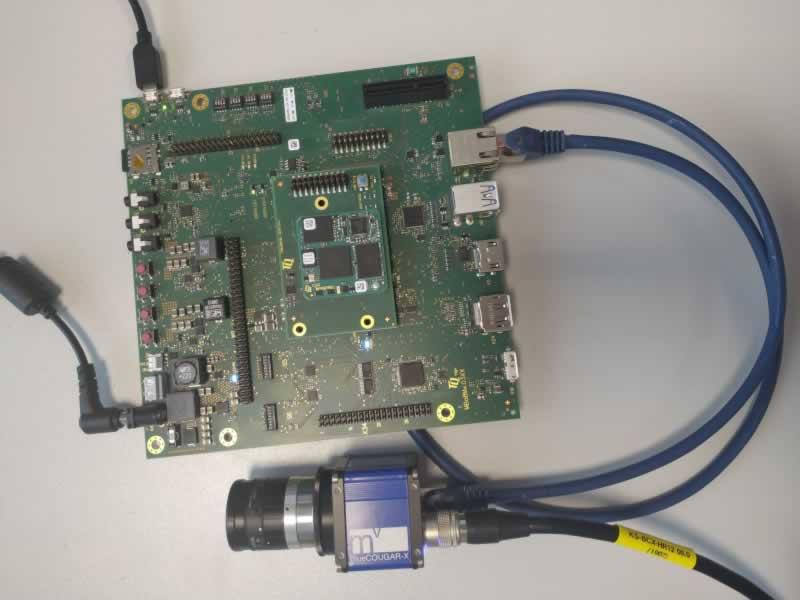i.MX8M Mini
General
| CPU | ARM Cortex®-A53 @ 1.6GHz |
| Cores | 4 |
| RAM | 1 GB |
| USB2.0 Interfaces | 2 |
| USB3.0 Interfaces | None |
| Ethernet | 1000 MBit |
| PCIe | 1 x 1 Lane Gen 2.0 |
The carrier-board used in this test: MBa8Mx from TQ-Systems GmbH
- Note
- If you are looking for more information and guidance about installing Impact Acquire packages via the Yocto Project, please choose an API-manual suited for your programming language and then go to chapter "Installation From Private Setup Routines → Embedded Linux → Yocto Project". All API-manuals can be found under https://www.balluff.com/en-de/online-manuals-mv.
Test Setup

Additional Settings
It is recommended to increase the network socket receive and send buffer size to 16MB. These values can be set permanently in /etc/sysctl.d/62-buffers-performance.conf:
| Setting | Value | Description |
| net.core.wmem_max | 16777216 | Maximum memory size of a socket buffer for sending in Bytes |
| net.core.rmem_max | 16777216 | Maximum memory size of a socket buffer for receiving in Bytes |
| net.core.netdev_max_backlog | 10000 | Maximum number of packets which can be buffered if the Kernel does not manage to process them as fast as they are received |
| net.ipv4.udp_mem | 10240, 87380, 16777216 | Minimum, Default and Maximum memory size of a UDP socket buffer for receiving and sending data in bytes |
- Note
- If
/etc/sysctl.d/62-buffers-performance.confdoesn't exist beforehand, create one. - Refer to Network Performance Settings for more information.
Benchmarks
- Note
- The tests using GigE Vision™ device were conducted using a MTU value of 1500 Bytes. This limitation is caused by the default kernel which only supports MTU value up to 1500 Bytes. In this case, a reliable data transmission can only be achieved when NO de-Bayering is carried out on the host system. If de-Bayering is required on the host system, the transmission bandwidth (i.e.
DeviceLinkThoughput) has to be limited (to e.g. 42[MB/s]) and theRequestCounthas to be increased (to e.g. 30) to avoid frame loss. If the NIC supports jumbo frames, you can also increase the maximum supported MTU (to e.g. 8000 Bytes) by customizing the kernel to improve the performance when de-Bayering on the host system. -
A
Requestin the Impact Acquire API represents a buffer where an image with the current device configuration is captured into. In order to avoid losing images at a high FPS, it's recommended to increase the number of these request buffers (i.e. 'RequestCount'in 'SystemSettings', by default the value is set to 10), so that the device driver can continue capturing image data even if the host application is sometimes slower at processing an image than the camera at transferring one.
The following scenarios have been tested:
- When de-Bayering is carried out on the host system: The camera delivers Bayer8 image data to the host system. The Bayer8 image data then get de-Bayered to RGB8 format on the host system. Due to the limited max. MTU of i.MX8M Mini, the transmission bandwidth (i.e.
DeviceLinkThoughput) has to be limited and theRequestCounthas to be increased to avoid frame loss in this case. Also see theNoteabove. - When no de-Bayering is performed: The camera delivers Bayer8 image data to the host system. No de-Bayering is performed. This settings results in a lower CPU load and a higher frame rate. The behavior is identical to monochrome cameras.
| Camera | Resolution | Pixel Format | Frame Rate [Frames/s] | Bandwidth [MB/s] | CPU Load (averaged over 4 cores) |
| mvBlueCOUGAR-X104iC | 2064 x 1544 | BayerRG8 (on camera) → RGB8 (on host) | 13.2 | 42 | ~28.25% |
| mvBlueCOUGAR-X104iC | 2064 x 1544 | BayerRG8 (on camera) → BayerRG8/Raw (on host) | 37 | 118 | ~22.6% |
